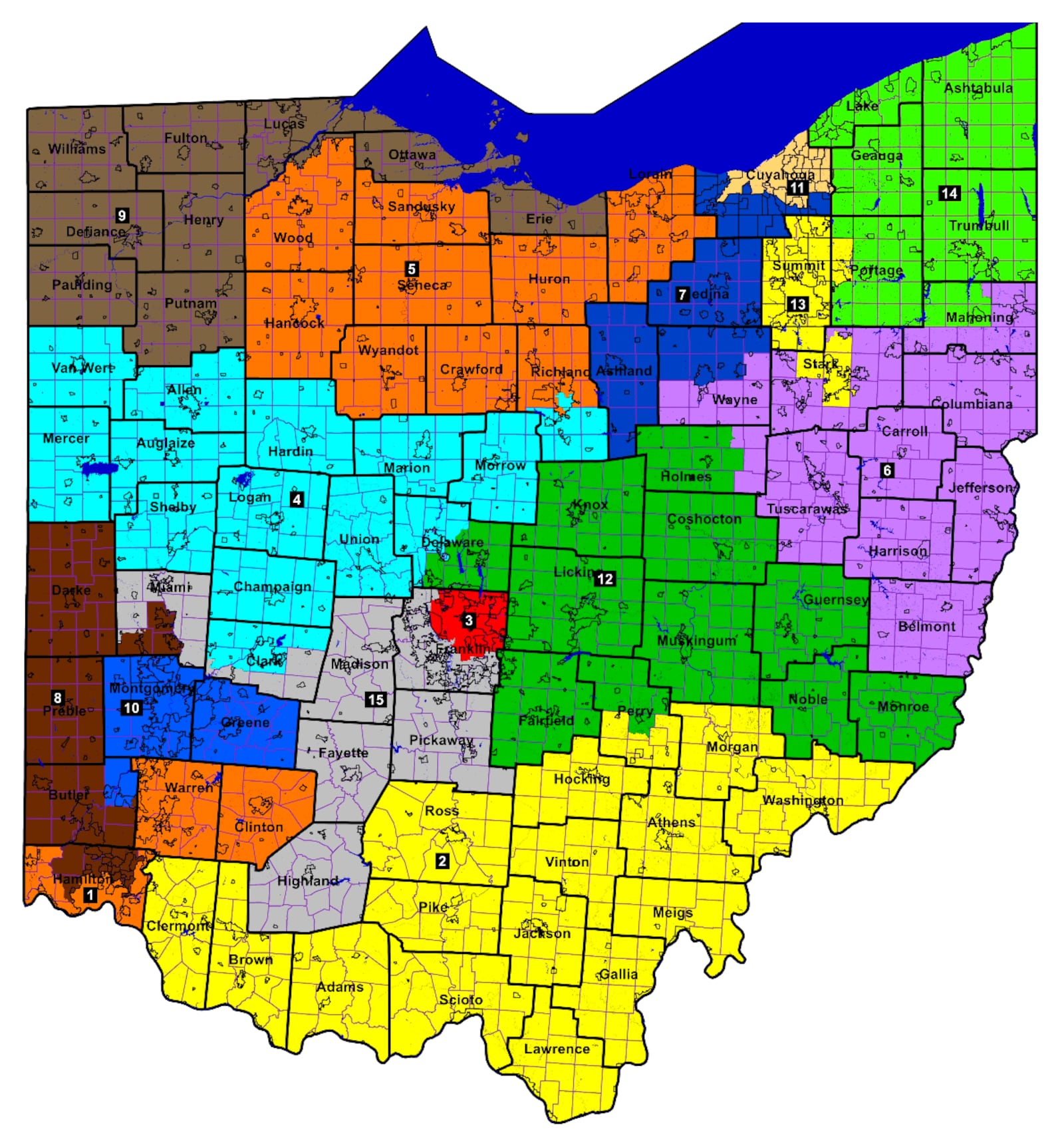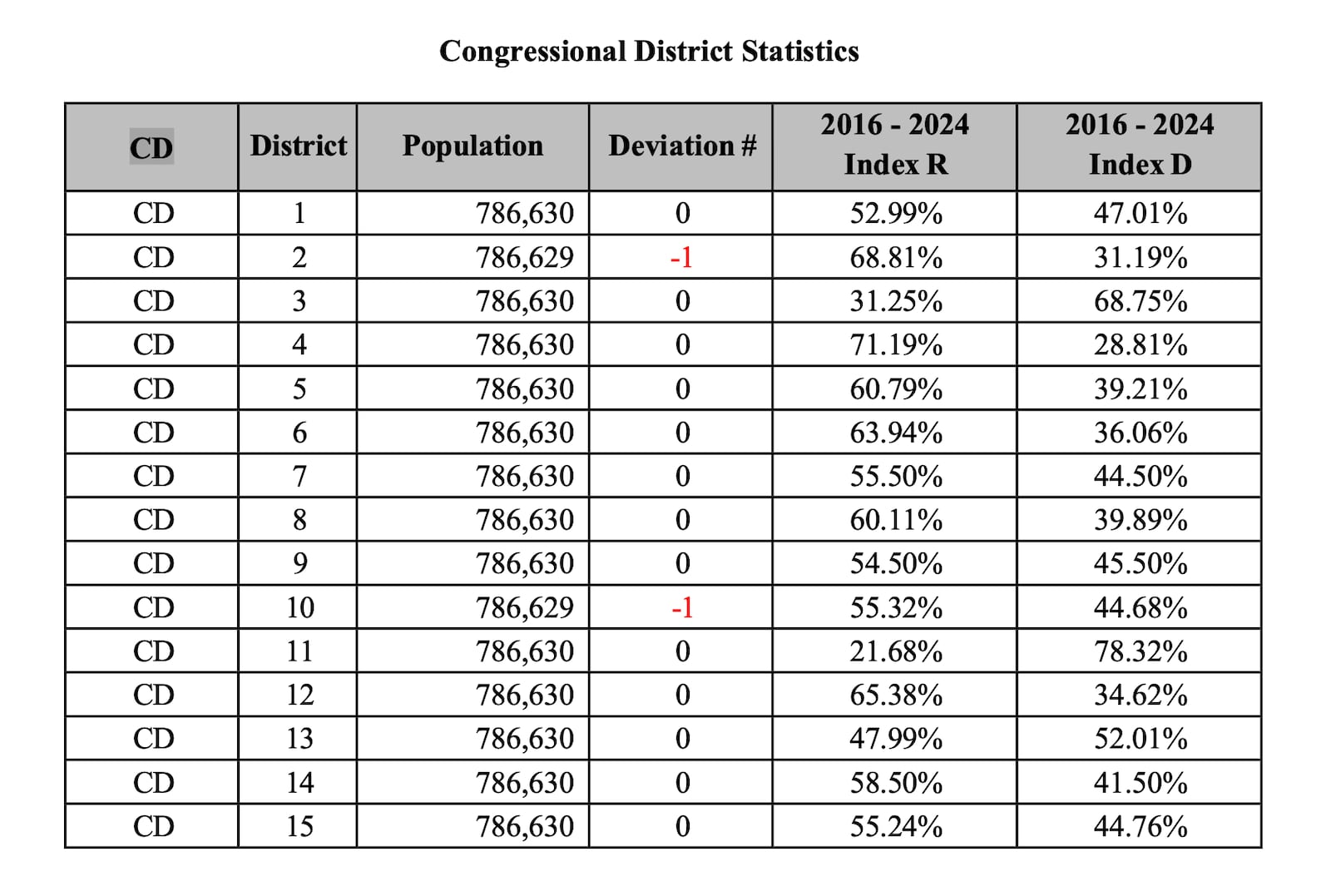The plan, publicly unveiled Thursday and hashed out through backroom negotiations between the two parties, was adopted by a 7-0, bipartisan vote of the Ohio Redistricting Commission. The new map will be used in the 2026, 2028 and 2030 elections.
The Ohio Redistricting Commission is made up of the governor, the auditor, the secretary of state, two individuals appointed by Republican statehouse leaders and two other individuals appointed by Democratic leaders. Republicans hold all of the statewide elected offices on the commission, meaning Democrats had two of the seven votes.
Ohio Rep. Brian Stewart, R-Ashville, who co-chaired the redistricting commission, told reporters Friday that the new map reflects the “overwhelming success” the GOP has had in Ohio in the past 10 years, winning all but one statewide contest and widening its margins in three presidential elections.
“The fact that there are 12 districts in which Republicans have a very good opportunity to be successful is something that our caucus is pleased about,” Stewart said.
Democrats’ mood was mixed after the vote. Legislative leaders begrudged the process, their position in the process, and said the newly adopted map was ultimately not the map they believed Ohioans deserved. Still, they projected confidence in the deal they struck with the GOP.
To reporters, House Minority Leader Dani Isaacsohn, D-Cincinnati, rejected a characterization that the new map gives Republicans a plain 12-to-3 advantage. He contended that the new map was functionally similar to the state’s previous map, which also gave Republicans a 12-to-3 advantage on paper but resulted, twice, in a 10-to-5 congressional delegation.
“Going into today, we had a map with three lean-or-safe Democratic districts and two toss-ups. Coming out of today, this is a map with three lean-or-safe Democratic districts and two toss-ups,” said Isaacsohn.
Isaacoshn’s assertion depends on how you define “safe” or “toss-up” districts.
This new map creates 10 districts that are safely Republican by more than 10 points (though two of those districts are on the cusp) and two districts that are safely Democratic. It has only three races that are within 10 points; two lean Republican by six and nine points, respectively, and the third leans Democrat by four points.
Had the commission not found a bipartisan compromise by the end of Friday, map-drawing power would have gone to the Republican-dominated Ohio legislature, which could have passed a map with a simple majority.
Allowing the process to seep into November, Democrats said, would have likely resulted in a 13-2 GOP advantage, with Democrats’ only recourse being an expensive referendum campaign that would have been difficult to pull off.
Stewart said Republicans didn’t get everything they wanted, either.
“You can look at commentary around not just the state but nationally and see that there are some people that would prefer we went a little further,” Stewart said. “You can draw a map that would have, you know, maybe a more aggressive number of seats, but I think both sides came and said, ‘Let’s have a map we both can live with.’”
The map
Credit: Provided
Credit: Provided
Credit: Provided
Credit: Provided
The new map’s most notable changes come in three districts currently held by Democrats. By redrawing boundaries, the new plan weakens Democrats’ chances in the Cincinnati area’s OH-1 and in the Toledo area’s OH-9, while solidifying Democrats’ hold over the Akron area’s OH-13.
In OH-1, a toss-up district won twice in a row by U.S. Rep. Greg Landsman, D-Cincinnati, the district will shift from what is now eastern Hamilton County and all of Warren County to instead consist of southern Hamilton County and all of Warren and Clinton counties.
OH-1’s projected partisan index, calculated by statewide voting patterns from 2014 through 2024, favors Republicans 52% to 47%. It’s the second-most competitive congressional district, on paper.
The plan similarly dilutes Democratic voting power in OH-9 in northwest Ohio, which was previously a toss-up district that has twice narrowly elected U.S. Rep. Marcy Kaptur, D-Toledo. The new district leans Republican 54.5% to 45.5%.
Isaacsohn told reporters that the new OH-1 and OH-9 would have been won by Democratic candidates in either 2022 or 2024.
The plan maintains Democrats’ existing strongholds in Columbus’ OH-3 and in Cleveland’s OH-11 and throws Democrats a bone in Akron, where U.S. Rep. Emilia Sykes, D-Akron, will have a 52% to 48% advantage.
Some area cities change districts
The remaining 12 districts, currently represented by Republicans, are relatively unchanged, politically.
In the Dayton area, OH-10, long held by U.S. Rep. Mike Turner, R-Dayton, would maintain a sturdy 10-point Republican advantage. One notable change is that Turner would pick up a portion of Butler County including Middletown, Trenton and Monroe.
Turner would no longer represent Springfield, which would be folded into the heavily Republican district OH-4, currently held by U.S. Rep. Jim Jordan, R-Urbana. OH-4 has a 71.2% Republican index.
The new map puts Troy in the district held by Republican Warren Davidson. Davidson is from Troy but currently only represents a sliver of land south of Troy. The city itself is represented by Mike Carey, a Republican from Columbus. The new map gives Davidson’s district Troy, as well as Tipp City.
Carey keeps much of Miami County in a sprawling district that goes through southern Clark County and extends east to Columbus and south to Highland County. The district, OH-15, has a 55.2% Republican index. It is the third-most competitive district in the state.
For more stories like this, sign up for our Ohio Politics newsletter. It’s free, curated, and delivered straight to your inbox every Thursday evening.
Avery Kreemer can be reached at 614-981-1422, on X, via email, or you can drop him a comment/tip with the survey below.
About the Author


